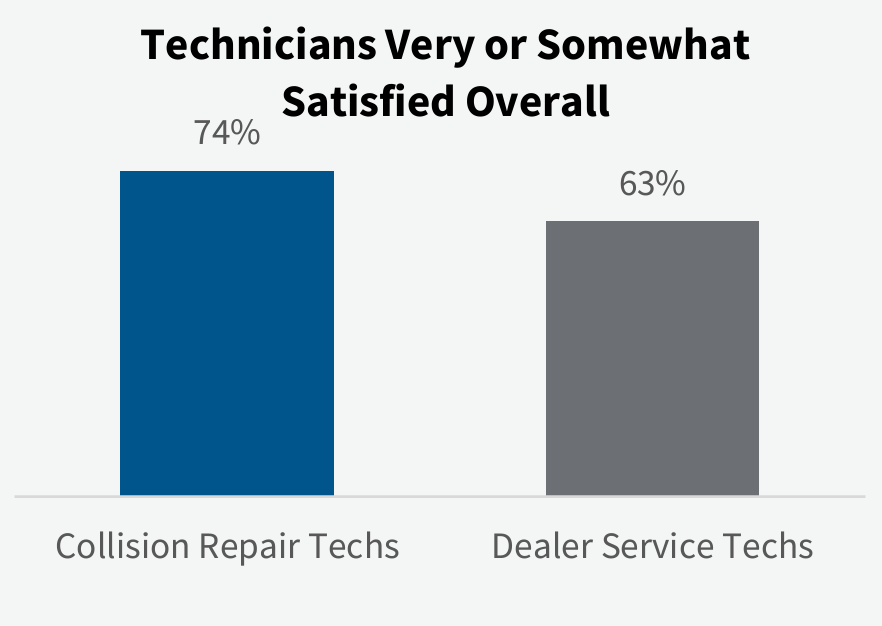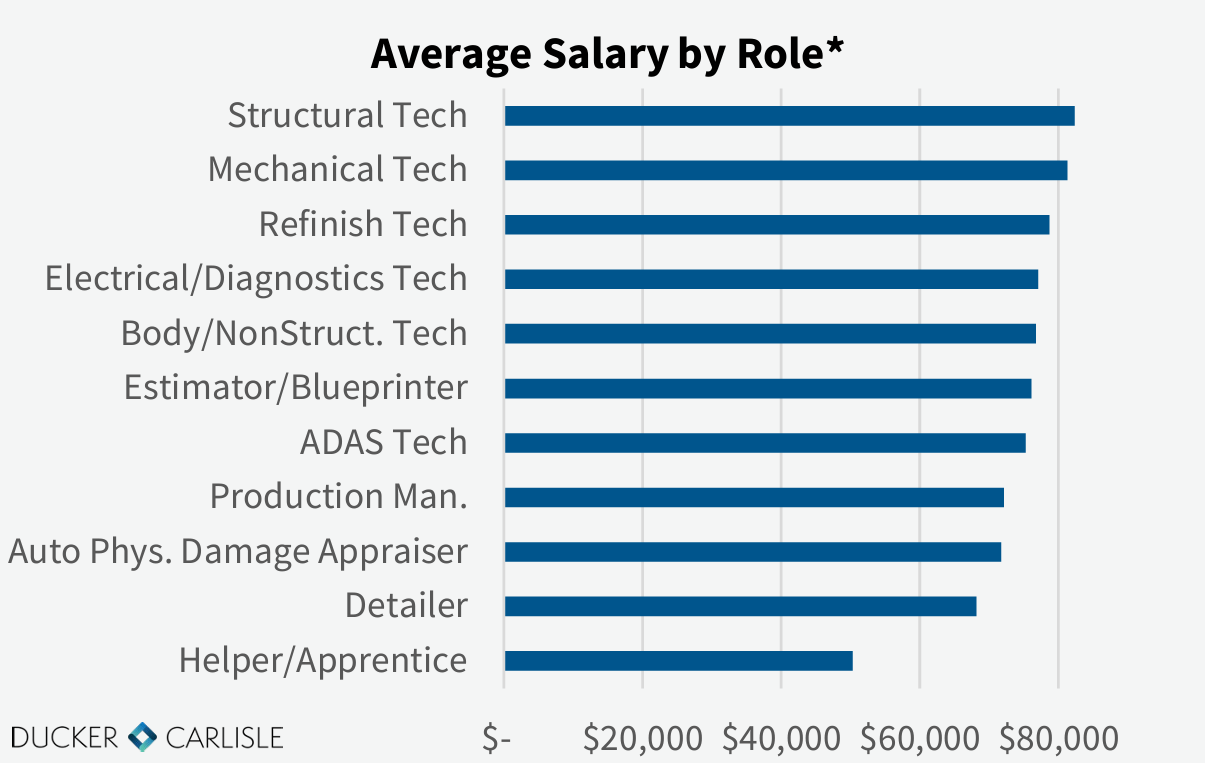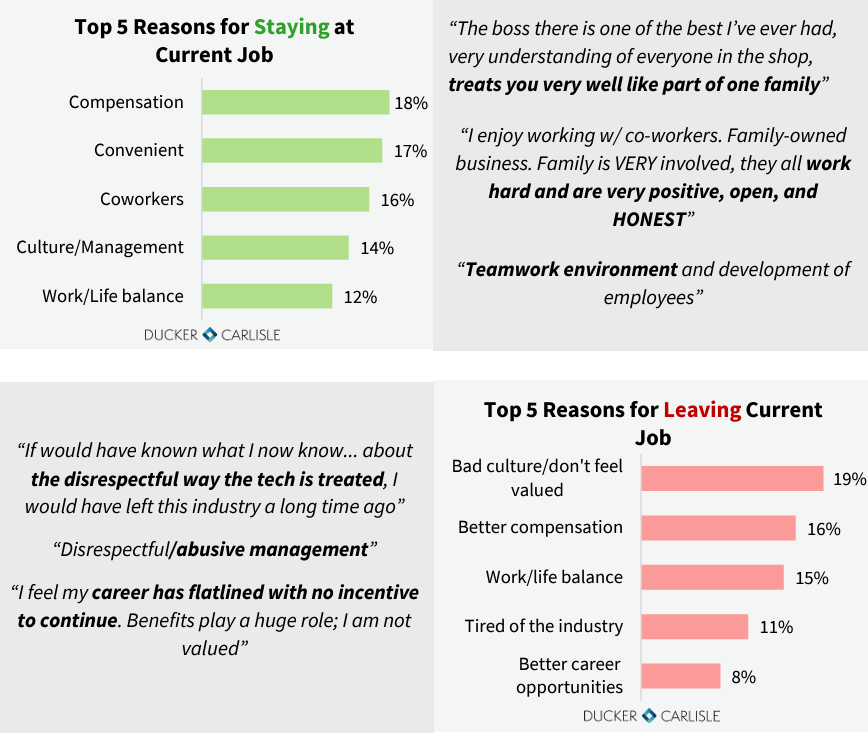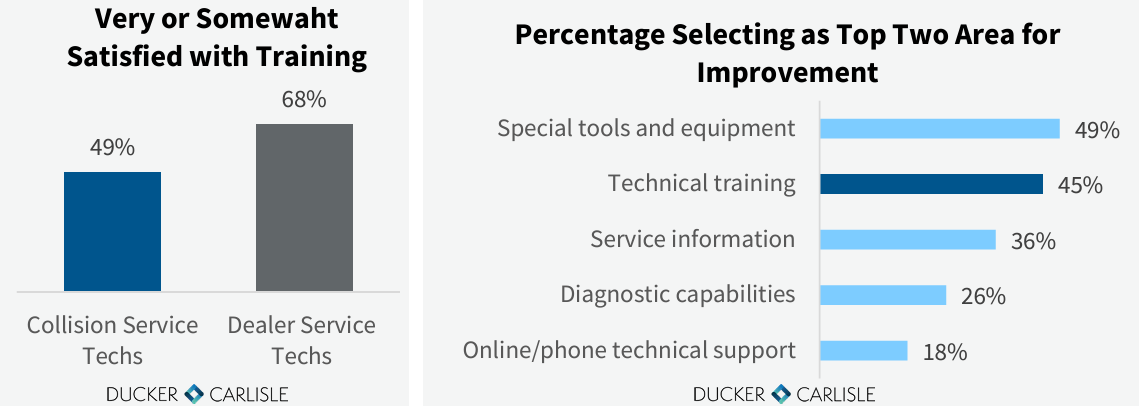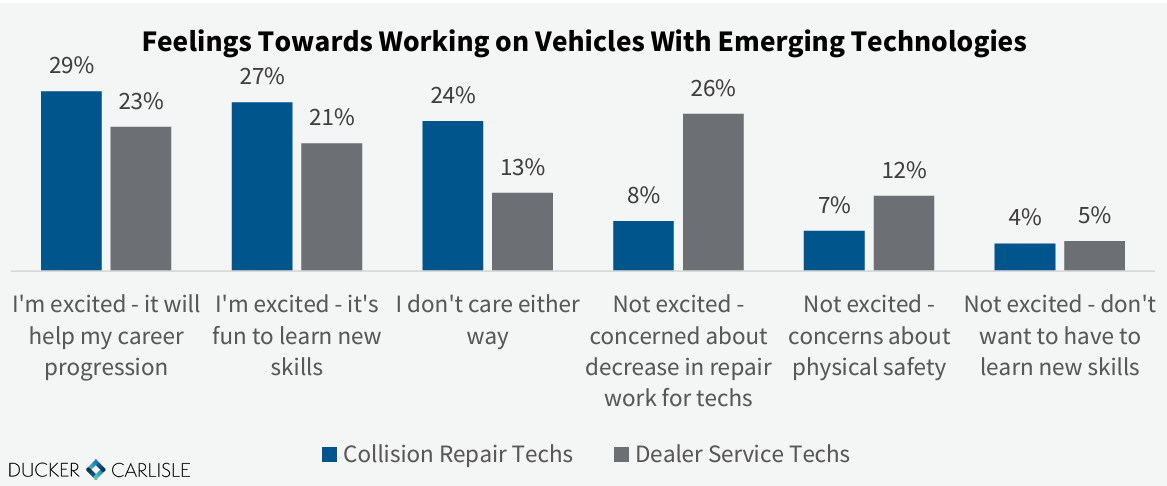
Whitepaper: 74% of techs satisfied with career overall, industry sees 30-40% annual turnover
By onBusiness Practices | Collision Repair
Shop culture, management, and overall team environment have a significant impact on technician career satisfaction and longevity in their job, according to recent survey results. In fact, culture is one of the top five reasons why technicians stay with their current employer, but bad culture and not feeling valued is the No. 1 reason why survey respondents noted leaving their job.
I-CAR, the Society of Collision Repair Specialists (SCRS), and Ducker Carlisle provide data and tips for addressing both and more in a whitepaper released today based on the findings from a collision repair technician satisfaction survey given late last year. Questions centered on compensation, culture, and career opportunities. More than 800 techs were surveyed.
The survey has also provided a basis for comparison to the automotive repair space from the eyes of diesel and mechanical technicians, which often compete with the collision repair industry for technician talent.
“The whitepaper’s groundbreaking results shed light on critical areas that need attention within our industry,” said Dara Goroff, I-CAR planning, and industry talent programming vice president, in a news release. “We’re already starting to provide solutions that address the issues contributing to attrition with the goal of enhancing technician satisfaction to help the industry attract, engage, educate, and retain the top talent that will foster the industry’s sustainability, growth, and success.”
SCRS Executive Director Aaron Schulenburg added, “The industry recognizes that collision repair technicians are indispensable to our business operations. Their pivotal role is evident, and the current industry landscape, marked by an annual turnover rate of 30-40% among technicians, underscores the challenges we face,” adds Aaron Schulenberg, Executive Director for SCRS. “In light of the pressing technician retention crisis, understanding the sentiments and career outlook of our skilled technicians has become a paramount concern for the industry’s sustained success.”
While recruiting new technicians is important, retaining those already employed is just as, if not more important, the release states.
Overall Satisfaction
As a whole, collision repair technicians express higher satisfaction levels compared to their dealer service technician counterparts, based on previous Ducker Carlisle surveys. However, there is room for improvement, as over a quarter of collision techs are unsatisfied and considering leaving their current roles within the next two years.
Collision repair shops typically see 30-40% employee turnover every year and face criticism of flat-rate pay systems.
Recommendations to address this shared in the whitepaper are:
-
- Conduct surveys, interviews, collect exit feedback, etc. to better understand any specific concerns and identify what you can improve
- Use the collected input as a recruitment tool by highlighting the areas you’re doing well in
Compensation and Pay Plan
Collision repair technicians have a high earning potential throughout their careers. Many experienced techs earn more than $100,000 a year. However, the survey findings show entry-level technician compensation is another area of opportunity for improvement.
Shops that pay on a flat rate have significantly lower employee satisfaction than shops that use other compensation models.
On average, technicians who work at larger, multi-location facilities earn slightly more than dealer techs — $84,000 versus $82,000.
Collision techs working at a single location, non-dealer facilities earn the least, on average, at $71,000. The survey didn’t ask whether techs worked at certified or uncertified shops.
More than 60% of technicians said they’re paid on flat rate pay plans — a fact that the whitepaper says should raise concern for the industry in its dislike. Flat-rate technicians also overwhelmingly would not recommend their career to friends or family.
“Despite these concerns, the fact remains that the flat rate system drives dissatisfaction,” the paper states. “This dissatisfaction is in stark comparison to every other type of pay plan (team-based, hourly, salary) — all of which represent technicians who would recommend the career. This is clearly a driver of career perception and may be impacting new technician recruitment.”
Repair facility operators are encouraged to address these issues by:
-
- Ensuring total compensation package(s) are in line with other employers in the area
- Ensuring competitive and fair wages by assessing pay methodology, especially if using a flat rate
- Working with technicians to understand what will motivate and incentivize them
Benefits Offerings
Benefits offered in the industry can vary widely based on the type of shop. Fifteen percent of survey respondents said the shops they work at lack benefits by either not being offered or through a lack of availability awareness.
“When designing benefit packages, collision shops must remember that their techs are not just looking at other technician jobs,” the paper states. “They see what their friends and family receive for benefits in their careers. Some technicians decide to leave the industry entirely, believing they have a better opportunity for a full benefits package elsewhere.”
Recommendations to address these issues include:
-
- Look at benefits packages outside the industry and match the local standards
- Regularly educate employees on the benefits that are offered, such as through educational meetings and enrollment overviews
- Ensure all employees, especially newer and younger techs, fully understand the benefits offered
An upcoming SCRS webinar, delivered by Decisely, will cover the basics of how shops can offer their employees benefits through the society.
With the SCRS Benefits Center, you can give your employees and their families access to coverage they can use without breaking your budget.
Decisely data among SCRS businesses shows full-time employees with benefits will stay twice as long as those without. When you offer your employees low-cost, no out-of-pocket plans, you can keep your employees happier, and much longer, SCRS said.
The webinar will be held on March 13 from 2-3 p.m. EST.
Career Outlook and Progression
Technician satisfaction with career advancement opportunities is inconsistent, with 43% expressing dissatisfaction or neutrality, or a lack of awareness about the opportunities available to them. The paper notes that career advancement opportunities are strongly correlated with overall technician satisfaction.
Clear career paths, frequent communication about career growth, and continuous learning are essential to enhance overall job satisfaction and retention, according to the paper.
While 96% of technicians who are “very satisfied” with their career advancement opportunities are very satisfied overall, just 13% are very dissatisfied with advancement.
Shop culture, management, and overall team environment also have a significant impact on technicians, and whether they stay at their jobs. Shop culture is the reason many want to stay, but it can also be the reason many want to leave, the paper notes.
To address this:
-
- Clearly outline different job levels, training requirements, and salaries available within your shop
- Help techs reach their goals
- Don’t be afraid to provide paths beyond the standard technician role – supporting techs in long-term career goals will go a long way for morale
- Foster a supportive shop culture
- Small things go a long way in demonstrating you care and that your techs are a valued part of your organization
Technical Training
Adequate training opportunities are crucial for technician satisfaction and long-term success. Collision repair technicians, on average, lack satisfaction with their technical training. Improved and more consistent implementation of training is critical for attracting and retaining a highly skilled workforce.
Ninety-one percent of techs who are “very satisfied” with training are satisfied overall, compared to 33% who are dissatisfied with their training.
Technical training is the second most selected improvement area behind special tools and equipment.
Recommendations for improvement:
-
- Take stock of the training your technicians receive
- Ensure your technicians understand all the training they need to maintain certifications and advance in their careers
- Provide support for technicians to complete training
- Help with financial costs, give time off, provide mentorship
- Provide full support to ensure they can complete training without any additional burdens
New Technology
Collision techs are generally excited about the opportunity to work on emerging vehicle technologies. More than half expressed enthusiasm.
This stands in contrast to dealer service tech counterparts, meaning a potential recruiting advantage for collision shops “by highlighting that working in the collision space will provide the best chance to work on the latest tech right away,” the paper states.
“At the same time, shops need to ensure they are providing proper training, tools, and equipment to safely work on this new technology. ‘Special Tools and Equipment’ and ‘Technical Training’ were the top two cited areas of improvement by technicians, implying there may be some techs out there who feel they’re unequipped to work on this technology — an issue that needs to be addressed.”
Ninety percent of techs said they work at repair facilities where repairs are made on vehicles with emerging technologies, such as electric vehicles and advanced driver assistance systems (ADAS).
Recommendations:
-
- Communicate benefits of new technology with the team
- Share thoughts about the future of the industry, career, and opportunities technicians may have to alleviate concerns
- Highlight new emerging tech with recruits
- Capitalize on the excitement around the overall industry and new technology developments to get recruits in the door
Images
Featured image: Stock photo of technician (Credit: wattanaphob/iStock)
All graphs pulled from whitepaper (Courtesy of I-CAR, SCRS, and Ducker Carlisle)

